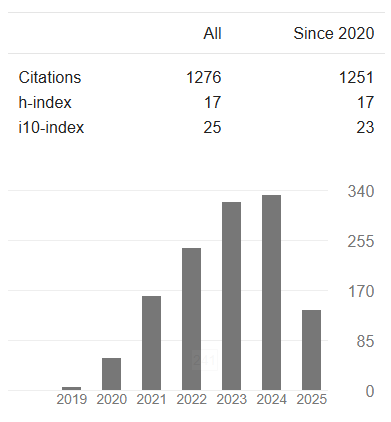Do Social & Psychological Factors Affect Investment Intention in Islamic Capital Markets?
DOI:
https://doi.org/10.14421/EkBis.2022.6.1.1484Keywords:
Theory of Planned Behavior, Cognitive Bias, Investment Intention, Sharia Capital MarketAbstract
This research aimed to predict social and psychological factors affecting individual investment decision in the Islamic capital market. Furthermore, the Theory of Planned Behavior Model (TPB) was used to explain irrational investor decisions affected by cognitive biases. We attempted to correct the pessimistic view of investors on the Islamic capital market using social & psychological perspectives. This study used a self-administered survey and obtained 82 investors and non-investors as respondents. The main criteria of individuals selected as respondents of the study were those who knew about the stock market and have heard the term Islamic capital market. This paper provided empirical insights on how the TPB model successfully explains the variance of change in investment intention. The results indicated that all predictors had a significant positive effect on individual investment intention. Individuals tend to exhibit a cognitive bias that lead to irrational decisions because individual’s attitude and PBC shape false perception of the usefulness of the Sharia capital market.
Downloads
 Abstract viewed: 746 times
|
Abstract viewed: 746 times
|
 PDF downloaded = 908 times
PDF downloaded = 908 times
References
Ahmad, Z., & Ibrahim, H. (2002). A study of performance of the KLSE Syariah Index. Malaysian Management Journal, 6(1&2), 25–34.
Ajzen, I. (2015). Consumer attitudes and behavior: The theory of planned behavior applied to food consumption decisions. Rivista Di Economia Agraria, 2, 121–138.
Ajzen, Icek. (1991). The Theory of Planned Behavior. Organizational Behavior and Human Decision Processes, August, 179–211. https://doi.org/10.1016/0749-5978(91)90020-T
Ajzen, Icek, & Fishbein, M. (1980). Understanding Attitudes and Predicting Social Behavior. Pretince Hall.
Ajzen, Icek, & Fishbein, M. (2000). Attitudes and the Attitude-Behavior Relation: Reasoned and Automatic Processes. European Review of Social Psychology, 11(1), 1–33. https://doi.org/10.1080/14792779943000116
Al-Ajam, A., & Md. Nor, K. (2013). Customers adoption of internet banking service: an empirical examination of the theory of planned behavior in Yemen. International Journal of Business and Commerce, 2(5), 44–58.
Al-Smadi, M. O. (2012). Factors affecting adoption of electronic banking : An analysis of the perspectives of banks ’ customers Factors Affecting Adoption of Electronic Banking : An Analysis of the Perspectives of Banks ’ Customers. International Journal of Business and Social Science, 3(17), 294–309.
Albaity, M., & Ahmad, R. (2011). A comparative analysis of the firm specific determinants of Syariah compliant versus non-Syariah compliant firms in Bursa Malaysia. Asian Journal of Business and Accounting, 4(1), 59–84.
Ali, S., Zani, R. M., & Kasim, K. (2014). Factor Influencing Investors’ Behavior in Islamic Unit Trust: An Application of Theory of Planned Behavior. Journals of Islamic Economics, Banking and Finance, 10, 183–201.
Amin, H., Rahim Abdul Rahman, A., Laison Sondoh, S., & Magdalene Chooi Hwa, A. (2011). Determinants of customers’ intention to use Islamic personal financing: The case of Malaysian Islamic banks. Journal of Islamic Accounting and Business Research, 2(1), 22–42. https://doi.org/10.1108/17590811111129490
Awn, Abdullah Mohammed, and F. A. (2020). LIBYAN INVESTORS’ INTENTION TO INVEST IN ISLAMIC SUKUK: THEORY OF PLANNED BEHAVIOUR APPROACH. European Journal of Economic and Financial Research, 4(1), 71–90.
Chapra, M. U. (2011). The Global Financial Crisis: Can Islamic Finance Help Minimize the Severity and Frequency of Such a Crisis in the Future ? Islamic Economics and Finance, 10(4), 135–142.
Chiadmi, M., & Ghaiti, F. (2012). Modeling Stock Market Volatility U sing the ARCH and GARCH Models: Comparative Study between an Islamic and a Conventional Index (SP Sharia VS SP 500). International Research Journal of Finance and Economics, 91(2), 138–150.
Davis, F. D., Bagozzi, R. P., & Warshaw, P. R. (1989). User Acceptance of Computer Technology: A Comparison of Two Theoretical Models. Management Science, 35(8), 982–1003. https://doi.org/10.1287/mnsc.35.8.982
Dayaratne D.A.E., A. W. A. W. G. C. N. (2015). Impact of Pcychology on Behavioral Intention in investing in Capital Markets: A Survei of Colombo Stock Exchange. International Journal of Accounting and Bussiness Finance, 2, 27–45.
Fishbein, M., & Ajzen, I. (1975). Belief, Attitude, Intention, and Behavior: An Introduction to Theory and Research. Addison-Wesley.
Fishbein, M., & Ajzen, I. (2005). The Influence of Attitudes on Behavior. The Handbook of Attitudes, July, 173–222. https://doi.org/10.1007/BF02294218
Fu, J. R., Farn, C. K., & Chao, W. P. (2006). Acceptance of electronic tax filing: A study of taxpayer intentions. Information and Management, 43(1), 109–126. https://doi.org/10.1016/j.im.2005.04.001
Gopi, M., & Ramayah, T. (2007). Applicability of theory of planned behavior in predicting intention to trade online: Some evidence from a developing country. International Journal of Emerging Markets, 2(4), 348–360. https://doi.org/10.1108/17468800710824509
Innan, R., & Moustaghfir, K. (2012). Predicting Employees’ Behavior: An Application of the Theory of Planned Behavior; The Case of the Moroccan Forestry Department (HCEFLCD). Knowledge and Learning: Global Empowerment; Proceedings of the Management, Knowledge and Learning International Conference 2012, 2006, 333–348.
Lockton, D. (2012). Cognitive Biases, Heuristics and Decision-Making in Design for Behaviour Change. SSRN Electronic Journal, November. https://doi.org/10.2139/ssrn.2124557
Lu, J., Yu, C. S., Liu, C., & Yao, J. E. (2003). Technology acceptance model for wireless Internet. Internet Research, 13(3), 206–222. https://doi.org/10.1108/10662240310478222
Ma’ruf, J. J., Mohamad, O., & Ramayah, T. (2005). Intention to purchase via the internet: A comparison of two theoretical models. Asian Academy of Management Journal, 10(1), 79–95.
Mathieson, K. (1991). Predicting user intentions: Comparing the technology acceptance model with the theory of planned behavior. Information Systems Research, 2(3), 173–191. https://doi.org/10.1287/isre.2.3.173
McGowan, Jr., C. B., & Muhammad, J. (2010). The Theoretical Impact Of The Listing Of Syariah-Approved Stocks On Stock Price And Trading Volume. International Business & Economics Research Journal (IBER), 9(3). https://doi.org/10.19030/iber.v9i3.532
Muzahid, M. A. U. and I. S. (2016). . Problems and Prospects of Islamic Capital Market In Bangladesh. International Journal of Ethics in Social Sciences, 4(2), 55–62.
Nasri, W., & Charfeddine, L. (2012). Factors affecting the adoption of Internet banking in Tunisia: An integration theory of acceptance model and theory of planned behavior. Journal of High Technology Management Research, 23(1), 1–14. https://doi.org/10.1016/j.hitech.2012.03.001
Natarajan, P., & Dharani, M. (2012). Shariah Compliant Stocks in India : A Viable and Ethical Investment Vehicle. Oman Chapter of Arabian Journal of Business and Management Review, 1(6), 50–62. https://doi.org/10.12816/0002108
Nurlita, A. (2015). Investasi Di Pasar Modal Syariah Dalam Kajian Islam. Kutubkhanah: Jurnal Penelitian Sosial Keagamaan, 17(1), 1–20.
Octarina, E., & Beik, I. S. (2019). CUSTOMER PURCHASE INTENTION ON SHARIA MUTUAL FUND PRODUCTS : A TPB APPROACH. Journal of Consumer Sciences, 04(01), 37–47.
Pasaribu, D. F., & Ridwan, M. (2015). The Extraordinary Solution for Indonesia Economic Crisis: Shariah Capital Market. Journal of Finance and Bank Management, 3(2), 93–101. https://doi.org/10.15640/jfbm.v3n2a9
Rahman, M., Isa, C. R., Tu, T., Sarker, M., & Masud, A. K. (2020). A bibliometric analysis of socially responsible investment sukuk literature. 995.
Rahmayanti, T. (2003). Analysis of Sharia Stock Portfolio Performance in the Indonesia Stock Exchange 2001-2002. Universitas Indonesia.
Ramayah, T., Nasurdin, A. M., Nasser, M., Noor, M., & Hassan, H. A. J. (2003). Students’ choice intention of a higher learning institution : an application of the Theory of Reasoned Action (TRA). Malaysian Management Journal, 7(1), 47–62.
Rhodes, R. E., & Courneya, K. S. (2003). Investigating multiple components of attitude, subjective norm, and perceived control: An examination of the theory of planned behaviour in the exercise domain. British Journal of Social Psychology, 42(1), 129–146. https://doi.org/10.1348/014466603763276162
Satsios, N., & Hadjidakis, S. (2018). Applying the Theory of Planned Behaviour ( TPB ) in Saving Behaviour of Pomak Households. 9(2). https://doi.org/10.5430/ijfr.v9n2p122
Setiawan, C., & Oktariza, H. (2013). Syariah and conventional stocks performance of public companies listed on Indonesia Stock Exchange. Journal of Accounting, Finance and Economics, 3(1), 51–64.
Shih, Y. Y., & Fang, K. (2004). The use of a decomposed theory of planned behavior to study Internet banking in Taiwan. Internet Research, 14(3), 213–223. https://doi.org/10.1108/10662240410542643
Soemitra, A. (2013). Shariah Ethical Investment Products in Indonesian Capital Market : The Debates on Their Integration Process in the Transitional Stage. February, 25–27.
Sultana, S. (2018). Environmental , Social and Governance ( ESG ) and Investment Decision in Bangladesh. 1–19. https://doi.org/10.3390/su10061831
Sumar’in, Teti Anggita Safitri, Yuliansyah, Sardjana Orba Manullang, and W. W. W. (2020). The Speculative Bubble in Indonesian Islamic Capital Market. International Journal of Advanced Science and Technology, 29(12), 1754–1766.
Taylor, S., & Todd, P. A. (1995a). Understanding information technology usage: A test of competing models. Information Systems Research, 6(2), 144–176. https://doi.org/10.1287/isre.6.2.144
Taylor, S., & Todd, P. A. (1995b). Understanding information technology usage.pdf.crdownload.pdf. In Information Systems Research (Vol. 6, Issue 2, pp. 144–176). https://doi.org/10.1287/isre.6.2.144
Teo, T. S. H., & Pok, S. H. (2003). Adoption of the Internet and WAP-enabled phones in Singapore. Behaviour and Information Technology, 22(4), 281–289. https://doi.org/10.1080/0144929031000119385
Tversky, A., & Kahneman, D. (1987). Nonwovens: sophisticated process technique. 185(4157), 1124–1131.
Venkatesh, V., & Davis, F. D. (2000). Theoretical extension of the Technology Acceptance Model: Four longitudinal field studies. Management Science, 46(2), 186–204. https://doi.org/10.1287/mnsc.46.2.186.11926
Warsame, M. H., & Ireri, E. M. (2018). Moderation effect on mobile microfinance services in Kenya: An extended UTAUT model. Journal of Behavioral and Experimental Finance. https://doi.org/10.1016/j.jbef.2018.01.008
Wilke, A., & Mata, R. (2012). Cognitive Bias. In Encyclopedia of Human Behavior: Second Edition (2nd ed.). Elsevier Inc. https://doi.org/10.1016/B978-0-12-375000-6.00094-X
Wu, I. L., & Chen, J. L. (2005). An extension of Trust and TAM model with TPB in the initial adoption of on-line tax: An empirical study. International Journal of Human Computer Studies, 62(6), 784–808. https://doi.org/10.1016/j.ijhcs.2005.03.003





























 This work is licensed under a
This work is licensed under a 